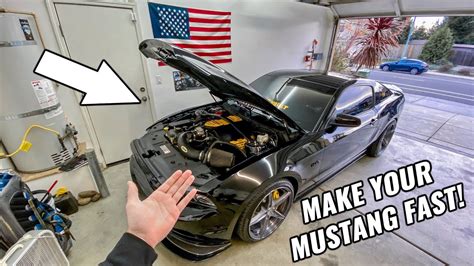
Exploring the Realm of V6 Engine Optimization: Unleashing Enhanced Performance and Efficiency
The V6 engine, with its compact design and inherent balance, has become a mainstay in the automotive industry. Found in a wide array of vehicles, from sedans to SUVs and even sports cars, the V6 offers a blend of power and efficiency that makes it a versatile choice. However, for those seeking to push the boundaries of performance and extract every ounce of potential from their V6 engine, there exists a vast array of modifications and techniques that can be employed to achieve this goal.
1. Unlocking the Power of Airflow: Intake and Exhaust System Modifications
The intake and exhaust systems play a crucial role in the engine's breathing process. Optimizing these systems can significantly improve airflow, resulting in enhanced power output. Replacing the stock air intake with a high-flow intake system, such as a cold air intake, allows for a greater volume of cool, dense air to enter the engine. This results in improved combustion efficiency and increased horsepower. Similarly, upgrading the exhaust system with a performance exhaust manifold and a free-flowing catalytic converter can reduce backpressure, allowing spent gases to exit the engine more efficiently. This leads to improved exhaust scavenging, resulting in better engine responsiveness and overall performance.
2. Optimizing Fuel Delivery: Fuel Injection System Enhancements
The fuel injection system is responsible for delivering the precise amount of fuel required for combustion. Upgrading to a high-performance fuel injector set can increase the fuel flow rate and improve atomization, leading to more efficient combustion and increased power output. Additionally, installing a fuel pressure regulator can allow for fine-tuning of the fuel pressure, ensuring optimal fuel delivery across the entire RPM range.
3. Turbocharging and Supercharging: Forced Induction for Enhanced Power
For those seeking substantial power gains, forced induction systems such as turbochargers and superchargers offer a potent solution. These systems utilize compressed air to increase the air density entering the engine, resulting in a significant boost in power output. Turbochargers harness the energy from exhaust gases to spin a turbine, which in turn drives a compressor to force more air into the engine. Superchargers, on the other hand, are mechanically driven by the engine's crankshaft, providing a constant boost in air pressure. Both turbochargers and superchargers can significantly increase horsepower and torque, transforming the V6 engine into a powerhouse.
4. Engine Management System Tuning: Unleashing Hidden Potential
The engine management system (EMS) is the brain of the engine, controlling various parameters such as fuel injection, ignition timing, and boost pressure. By modifying the EMS through ECU tuning or aftermarket engine management systems, it is possible to optimize these parameters for improved performance and efficiency. Tuning can adjust ignition timing for more precise combustion, optimize fuel maps for better air-fuel ratios, and fine-tune boost pressure for turbocharged engines. These modifications can result in increased horsepower, smoother power delivery, and improved fuel economy.
5. Lightweight Components: Reducing Weight for Enhanced Performance
Reducing the overall weight of the vehicle can have a significant impact on performance, especially in the case of acceleration and handling. Replacing heavy stock components with lightweight alternatives, such as carbon fiber body panels, aluminum wheels, and lightweight suspension components, can reduce unsprung weight and improve the vehicle's power-to-weight ratio. This leads to improved acceleration, braking, and overall agility.
6. Drivetrain Upgrades: Optimizing Power Transfer
The drivetrain, consisting of the transmission, driveshaft, and differential, is responsible for transferring power from the engine to the wheels. Upgrading these components can improve power transfer efficiency and reduce drivetrain losses. A performance transmission with closer gear ratios can provide quicker acceleration and improved responsiveness. Upgraded driveshafts made from lightweight materials can reduce rotational inertia and improve power delivery. Finally, a limited-slip differential can improve traction and handling, especially in slippery conditions.
7. Suspension and Handling Enhancements: Achieving Dynamic Balance
Optimizing the suspension and handling characteristics of the vehicle can greatly improve its overall performance and driving dynamics. Upgrading to a performance suspension system, consisting of stiffer springs, upgraded dampers, and adjustable sway bars, can reduce body roll and improve handling precision. Upgraded brakes with larger rotors and high-performance brake pads can provide enhanced stopping power and reduced fade under heavy braking.
8. Aerodynamic Improvements: Enhancing Efficiency and Stability
Improving the vehicle's aerodynamics can reduce drag and improve stability at high speeds. Adding a front splitter, rear diffuser, and side skirts can help manage airflow around the vehicle, reducing drag and increasing downforce. These modifications can result in improved fuel efficiency, increased top speed, and enhanced stability during high-speed driving.
9. Regular Maintenance and Professional Tuning: Ensuring Optimal Performance
Regular maintenance and professional tuning are essential to ensure that all modifications and upgrades are functioning properly and that the engine is operating at its peak performance. Regular oil changes, spark plug replacements, and fluid flushes help maintain engine health and longevity. Professional tuning by experienced technicians can fine-tune the engine management system for optimal performance and ensure that all modifications are working in harmony.
By implementing these modifications and techniques, it is possible to significantly enhance the performance and efficiency of a V6 engine. However, it is important to note that some modifications may require specialized knowledge and expertise to install and tune properly. It is always recommended to consult with experienced automotive professionals before undertaking any major modifications to ensure safety and optimal results.